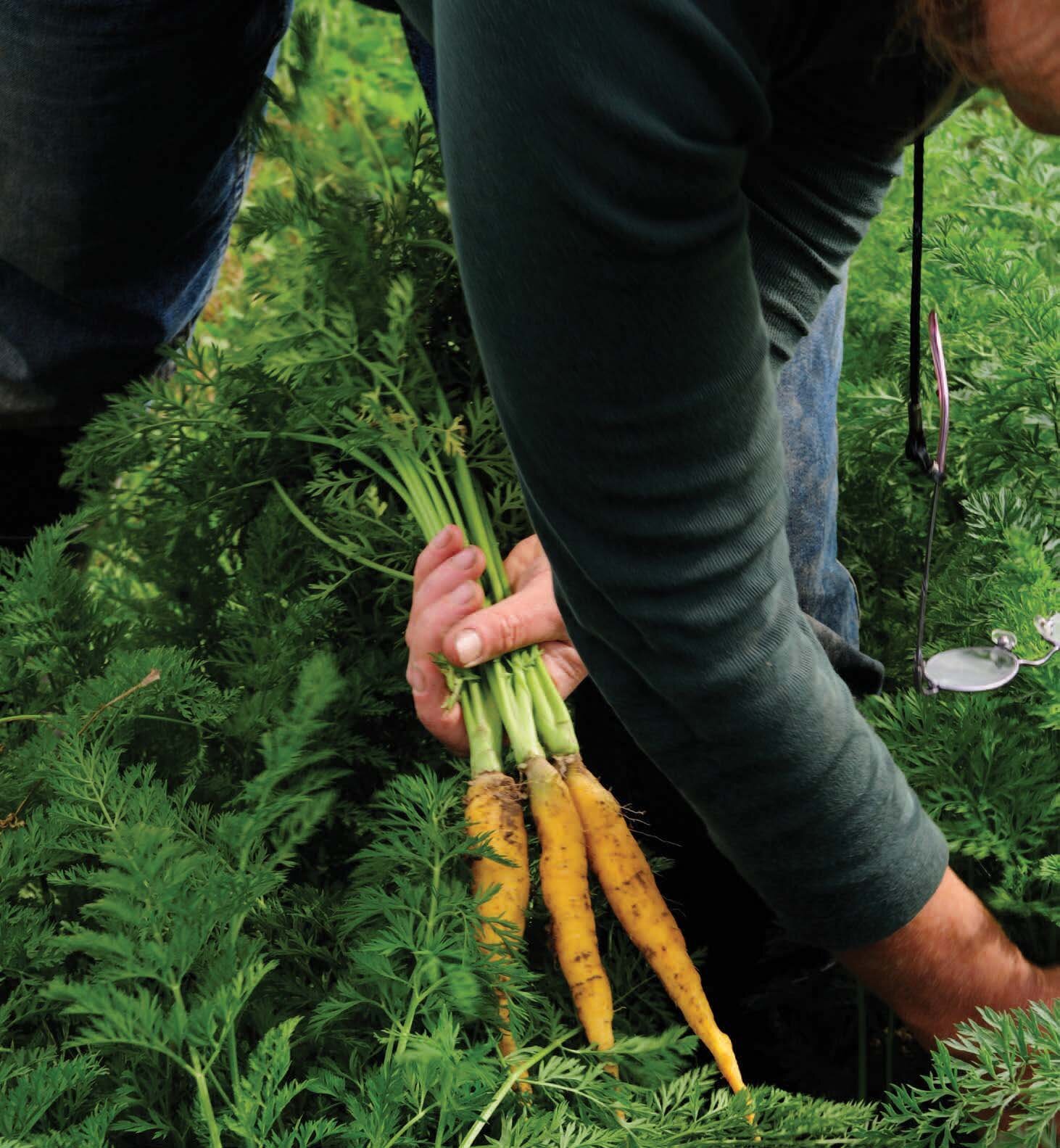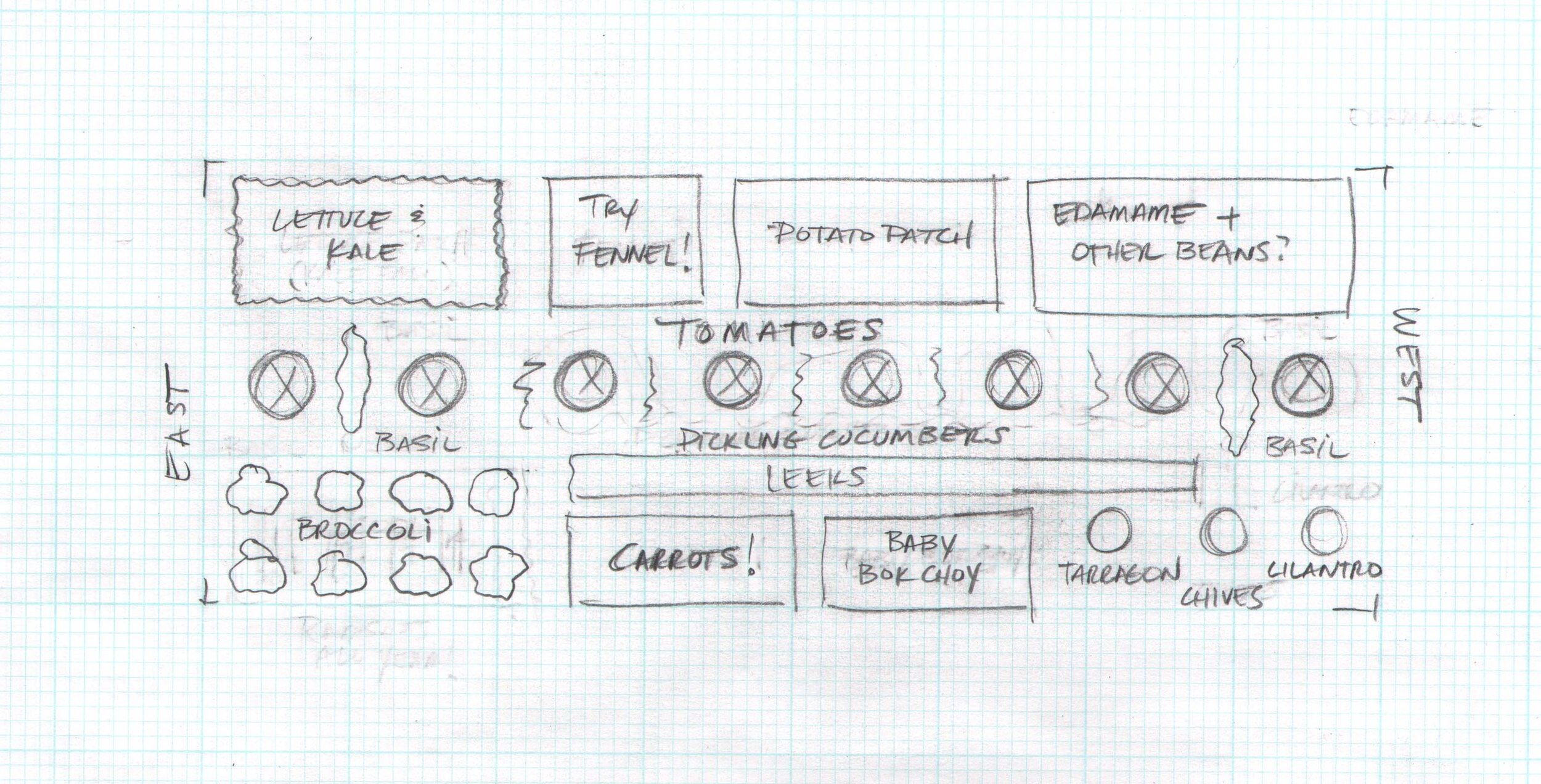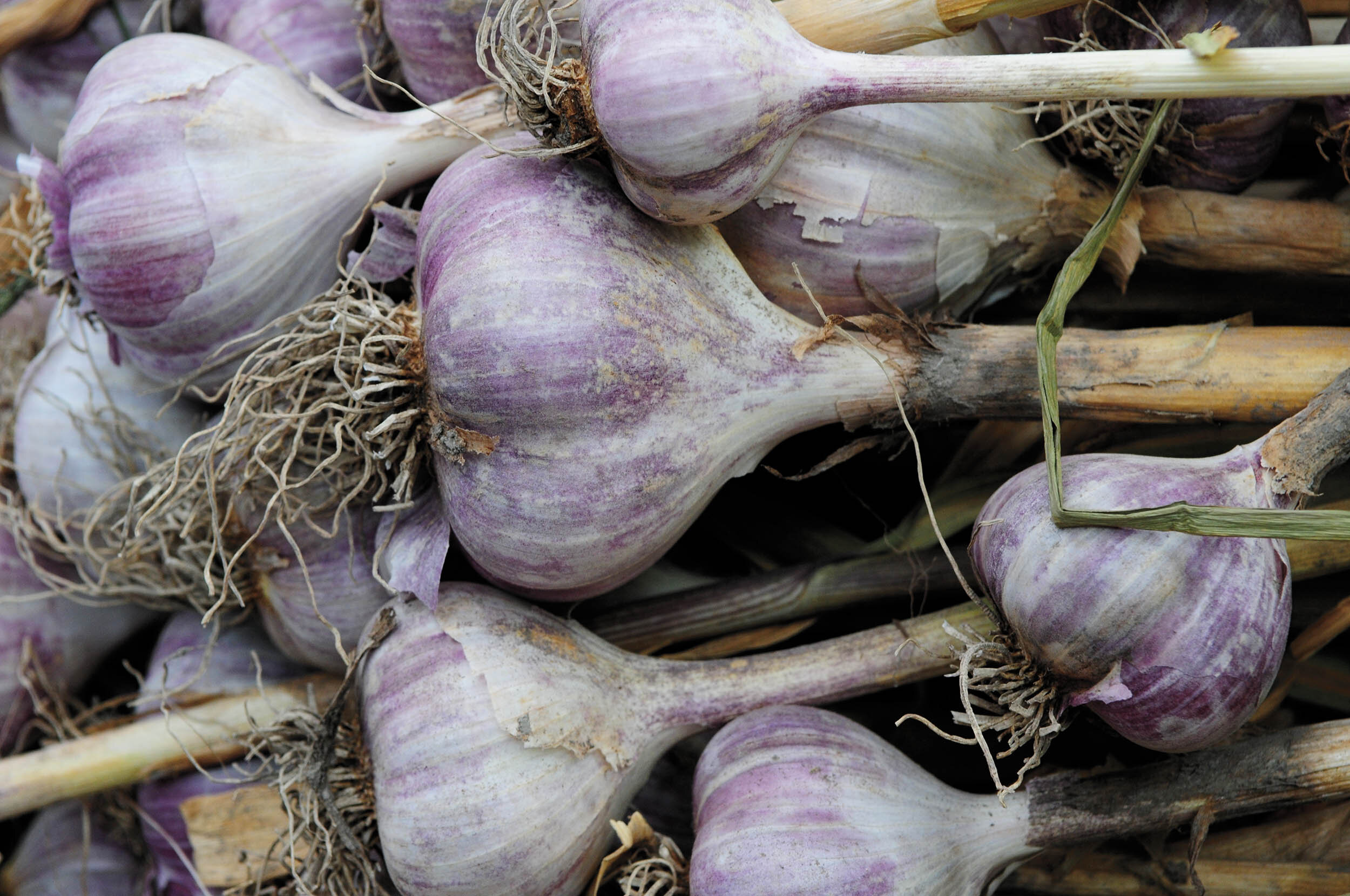The Autumn Garden

My neighbors think me flat out bonkers, I’m certain, high-stepping it through snow and slush in flimsy shoes, only to stop before a random patch of leaves poking through nature’s white blanket and begin, inexplicably, digging. In those freezing moments, prying leeks or carrots out of the crusty ground with a too small shovel, I question my own sensibilities, quite frankly. Here’s the thing: I can’t help it. I’m addicted. Addicted to my garden and the treasures it produces.
The reward is not a temporary high — it’s quite substantial and healthy, I assure you: a fresh leek, perfectly white and green, three feet long from root to leaf tip, grown from seed in March, and efficiently preserved in the cold December soil. A quick detour to the thyme hedge, evergreen and flavorful, and it’s back to the house. Dinner is potato and leek soup, ingredients — including organic fingerling potatoes, herbs, and homemade vegetable stock — courtesy of this crazy garden that has me voluntarily slogging through the elements in unflattering rubber clogs and frost-heeled socks.
That scene, from Decembers both past and future, is what keeps the gardening spark alive. In a season of stillness and waiting, I pull fresh, crunchy life from the ground. It’s miraculous. It’s magic. It’s the bounty of the four-season vegetable garden.
In this article, and throughout the year, I’ll step through a year in my home vegetable garden, season by season: the bright successes, the eye-opening experiments, and, of course, the organized to-do list for planning, planting, and harvesting, without which I could manage to grow only crabgrass.
Autumn
October is the traditional end to the gardening season, when we say goodbye to fresh corn, heirloom tomatoes, ridiculously tender green beans and sweet bell peppers, pull the last of the great pumpkins and hoard away butternut, delicata, and spaghetti squash for a winter of hearty soups and stews.
In the four-season garden, it’s also a beginning. Autumn — not spring — is when we lay the foundation for next year’s harvest, all the while defying nature by continuing to coax green things from the pale and frosty ground.
I allow my summer crops to linger as long as they can before pulling. This means tomatoes, peppers, potatoes, squash, and herbs well into October. I’m a natural procrastinator, so this delay in putting the garden to bed fits both my personality and my unsubsiding craving for fresh heirloom tomatoes. Meanwhile, cool weather crops — broccoli, cauliflower, beets, carrots, parsnips, cabbage, kale (and other greens), a second round of radishes and peas — continue maturing on schedule.
Plan and Prepare
Although we typically think of early spring as the time when we roll up our sleeves, pull on our Wellies, and go play in the mud, autumn is the better time to get a jump on next year’s garden, particularly in terms of preparing the soil. A garden is only as good as its soil and deserves a season of focus and pampering. Here’s the autumn to-do list:
Start or renew your composting efforts. With the heat component missing, the winter compost pile will not be productive in terms of creating nutritious organic matter. Rather, you’re stockpiling valuable vegetable materials, which will kick into composting high gear with next spring’s warm-up.
Tear down your summer garden, removing all stray leaves, fruit, and vines. If they’re disease-free, add them to your compost pile. Otherwise, dispose of them.
Make some leaf mold. If you have leaf-shedding trees in your yard, rejoice: leaf mold is yours for the having. Leaf mold is simply well-composted, shredded leaves that have been broken down into a light, sweet humus by beneficial fungi and will contribute valuable nutrients to your soil. A mulching lawnmower or leaf shredder makes fast work of chopping up the leaves into fungus bite-sized bits. Store them slightly damp in garbage cans or large garbage bags. Leaf mold will take more than a year to form, but if you collect enough leaves, you can use part of the store to feed your regular compost piles next year, and preserve the rest to develop into true leaf mold for the following year’s garden.
If you’re new to gardening or looking to expand, now is a good time to choose the location. If your yard is wide open to the sunshine in all directions, your options are, likewise, wide open. For others, myself included, we have to follow the sun and lay the garden outside the edges of shade trees and other structures that block the sun. Most crops need 4 to 6 hours of direct, full sunlight. Step out into your yard morning, midday, and late afternoon, and observe where the sun hits, keeping in mind that the sun follows a higher arc in the sky in May, June, and July. This will guide your selection.
If you can dig up a patch of ground and amend the soil, all the better. It doesn’t have to be perfectly measured and bordered at this point. Just remove the grass and turn beneficial materials — compost, fresh grass clippings, and chopped leaves — into the soil. Cincinnati’s soil is a patchwork of mediums. If you live in the ‘burbs, as I do, your top foot of soil was probably shipped in from elsewhere during construction. My own yard is a maddening mix of clay on one side, and nutritionally spent dust on the other. Improving the soil is an ongoing effort, but the most important of autumn and spring activities.
If you’re feeling particularly ambitious, sow a cover crop of clover or rye, which will grow over the winter and be fit to turn into the ground the spring.
Sign up now for seed catalogs, if you don’t already receive them. The big, beautiful spring editions begin arriving late December and are chock full of gardening inspiration and crop ideas. Visit the websites of seed and plant producers and look for the link to receive their catalogs.
Plant and Tend
Gardening is absolutely a passion of mine, but make no mistake: by November, I’m tuckered. The cyclical nature of our growing season kindly factors in downtime, when we rest our backs, clear our minds, and show mercy on our water bills.
Autumn planting tasks are light and easy on the bones. Vegetables fit for winter harvesting — carrots, leeks, parsnips, beets (root vegetables, all) — continue their production, protected from the elements in their snug dirt home. Herbs such as flat-leaf parsley, thyme, and sage carry on without so much as a hiccup, even as the first snow flies. (Basil, by comparison, will unceremoniously swoon to the garden floor with the first light frost. Diva.)
garlic and shallots
Which brings us to autumn’s darlings, this gardener’s secret pride and joy and a cook’s best friends: garlic and shallots. Members of the Allium genus (which includes other the aromatic favorites, onions, chives, and leeks), garlic and shallots brew underground during the winter, easily surviving our unpredictable weather.
Far easier to grow than even tomatoes or peppers, you simply plant them in late October, cover with a nice, thick layer of mulch … and forget about them until the ground thaws in March or April.
It’s too late to order garlic or shallots online; however, a perfectly acceptable source is our area’s own magnificent collection of local farmers’ markets. Since the garlic and shallots we plant are the very same as what we eat, scoring a locally grown head of Georgian Crystal, Chesnok Red, or Music (delicious hardneck garlic varieties that produce those culinary wunderkind, garlic scapes, in the spring) or some French or Dutch shallots will fulfill both your evening meal and your winter garden. Locally sourced garlic and shallots will also have the advantage of being acclimated to our Cincinnati environment and should produce a spectacular first harvest.
greens
I find it simply amazing that we can grow the fragile, paper-thin lettuce leaf in all but the worst of winter weather. With a little protection, greens will shrug off conditions that leaves us humans high-tailing it for the comfort of our furnace-heated homes.
Sown in late August or early September, greens will mature before our first hard frost. If you plant later, you’ll need to build a protective covering over the seedlings — a cold frame or small hoop house — to prevent the ground from freezing. Such a structure will let you grow greens through late fall and early winter, and provide a very early jump on spring greens next year.
herbs
For the cooks among you, I cannot recommend highly enough starting your own herb garden. Very low maintenance, herbs are easy to grow, inside or out. In fact, many herbs are perennials and hardy for our climate: plant them once and you’ll be gifted with fresh herbs for years to come (I have an oregano plant that turned 12 this year).
Mint, oregano, marjoram, chives, and sage survive the winter, dormant, and grow back each year. Prepare for their winter snooze by trimming back their leaves and woody branches and cover their bases with mulch. (Note that mint is extremely invasive and will take over your garden if given half a chance. I grow mint in pots and move them into the garage for the winter.)
Most perennials, such as mint, oregano, marjoram, and lavender have moved past their prime flavor stages by the fall — leave them be. Sage leaves will still be soft and viable, quite suitable for cooking. Continue to pick flat-leaf parsley for as long as it remains green.
Flat-leaf parsley is a biennial that will survive all but our coldest temperatures and go to seed the following spring. Its leaves can be harvested for cooking all winter long. Rosemary is a questionable perennial in our area. In mild winters, rosemary will survive outdoors with a thick mulching around its base. The safest bet, however, is to transplant it to a pot, where it will survive indoors for most of the winter.
Annual herbs, such as basil, cilantro, and cumin will die off with the first light frost. Basil stems can be cut and preserved indoors in a glass of fresh water on the windowsill for several weeks.
Evergreen herbs, such as thyme and rosemary are well-suited for winter harvesting. Thyme survives well outdoors, while rosemary, quite the finicky specimen, survives better transplanted to a pot and brought indoors to a cool, humid environment. Take clippings of thyme and rosemary at any time, even in the dead of winter.
harvest
Sensibly, the vegetables able to survive our cold winters are the ones that grow underground, nestling their edible roots deep into the cozy soil, protected from the elements. These stew and soup mainstays need a good head start in warmer weather so that they can develop to maturity before hunkering down for the winter.
root vegetables
Carrot, parsnip, and beet seeds should be sown in August, about the time we’re hip deep in fresh tomatoes and crunchy cucumbers. Leeks, the rascals, require four to six months in the ground, depending on the variety. I start those seeds indoors in March, and plant the wispy seedlings in the ground in June for an ongoing harvest beginning in October. Root vegetables will last through fall and winter without — in my opinion — sacrificing flavor, and can be pulled as needed (even in the snow).
saffron
For one of those eye-opening experiments I mentioned earlier: Did you know that we can grow saffron — the world’s most expensive spice — in Cincinnati? Saffron is the stigma found in fall-blooming crocus. One initial investment in bulbs late in the spring means year after year of your very own autumn saffron harvest. (Bonus: it’s ridiculously easy to grow and your foodie friends will be jealous that you grow your own saffron, while they pay upwards of $100 per 1/4 ounce.) Saffron crocuses bloom for one day over a short stretch in November, and the red stigmas must be plucked while the lavender buds are open. After a short, open-air drying period, Risotto alla Milanese is yours for the having, on the cheap.
looking ahead
In the next issue, you’ll find me thumbing eagerly through seed catalogs, planning and dreaming about my gardens.
Karen is a four-season vegetable gardener and seed-totable advocate, blogging at SoupAddict.com. Her current garden crushes include black heirloom tomatoes, dill, lovage, and a small bay laurel shrub that flavors her soups. Her most heartfelt wishes are for world peace (of course), kindness to animals, bike lanes in Anderson, and for everyone to grow something edible at home.





